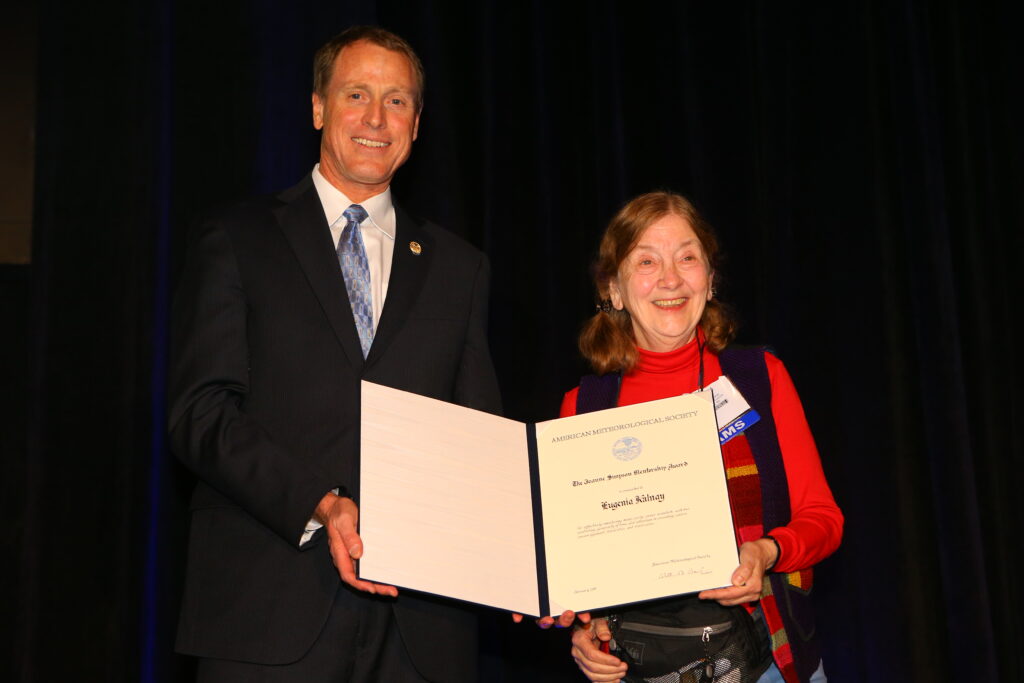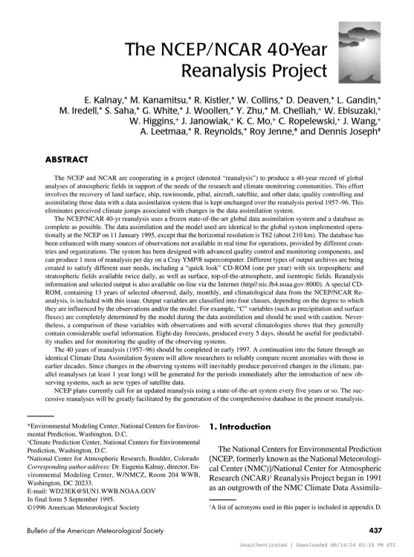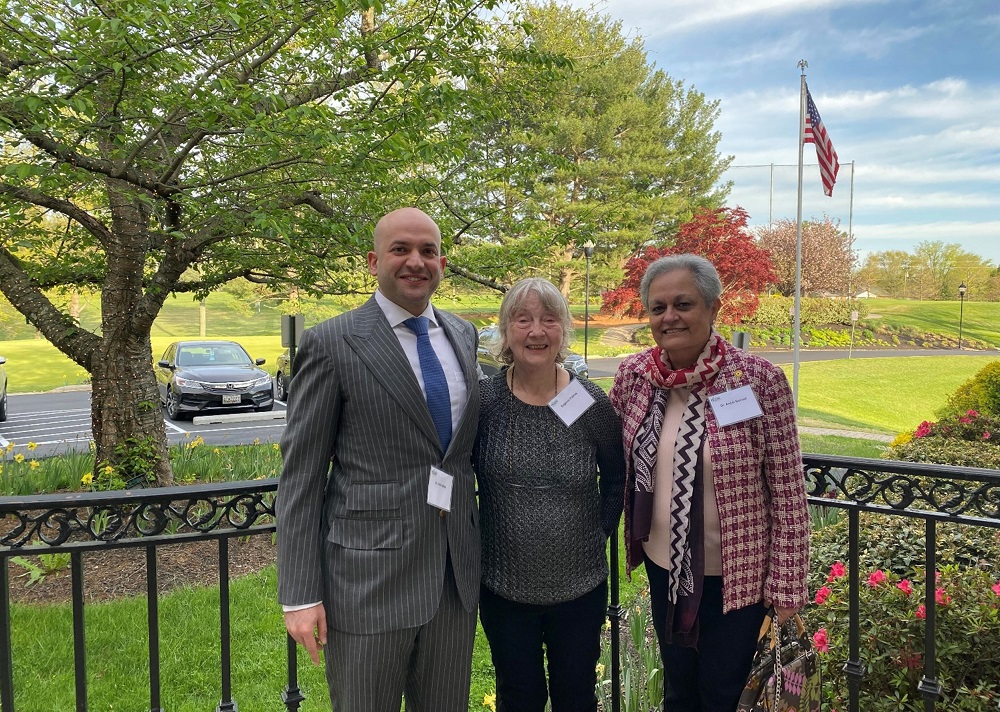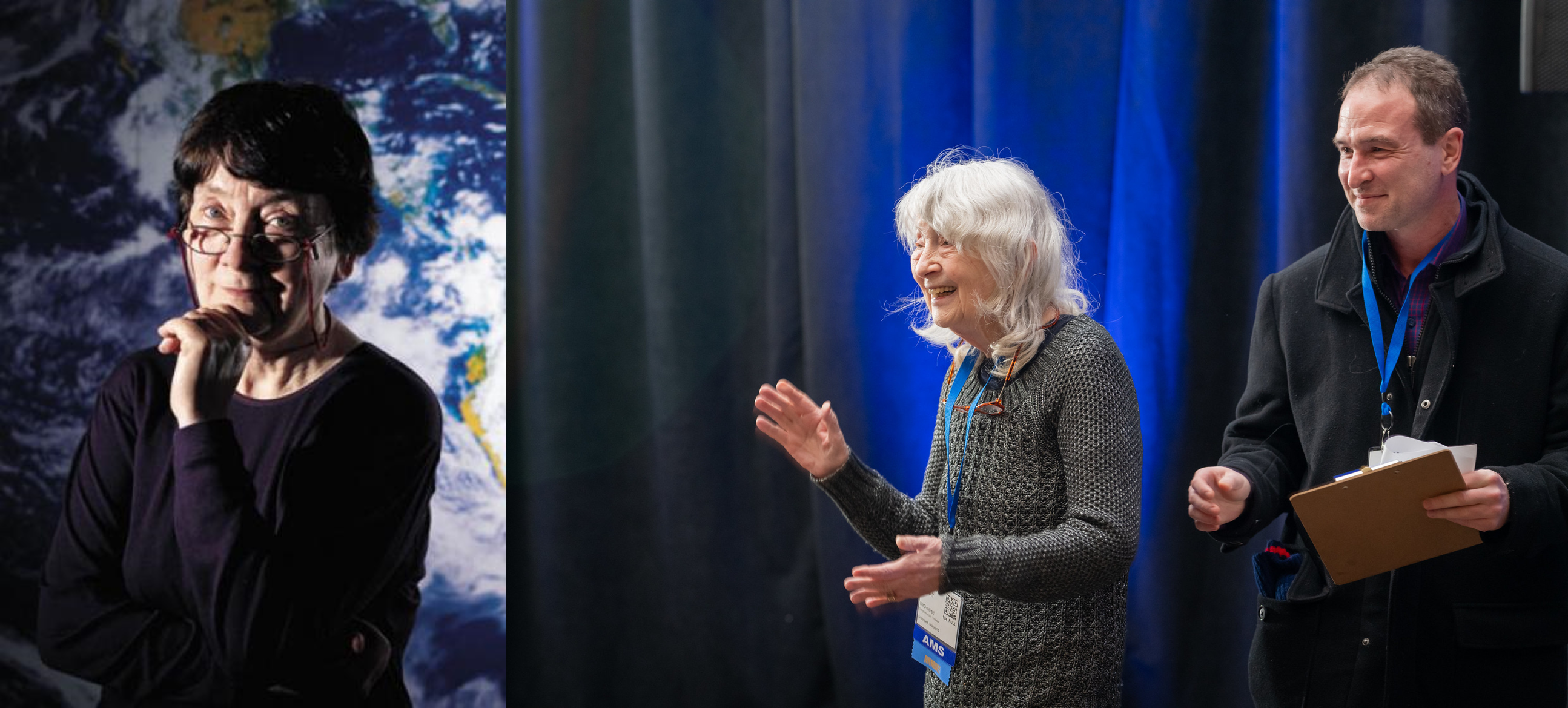We stand on the shoulders of gentle giants
By Anjuli S. Bamzai, PhD, AMS President
Last month, we lost a giant in the field of meteorology. Through the course of her illustrious career, Eugenia Kalnay pioneered not only the fundamental science and practical applications of numerical weather prediction, she also influenced many careers. Her scientific contributions and leadership led to improved forecasts, helping save lives and property across the globe and making U.S. weather and seasonal climate prediction world-class.
Kalnay had deep ties with the AMS. In 1982, she became a Fellow of the AMS. She was elected to the AMS Council in 1995. In 2015, a named Symposium was held in her honor at the 95th AMS Annual Meeting in Phoenix. The list of awards she received from the AMS includes the following: Jule G. Charney Award (1995), Joanne Simpson Mentorship Award (2015), Honorary Member (2015), and the first ever Jagadish Shukla Earth System Predictability Prize (2024).

Kalnay exemplified simple living and high thinking. She demonstrated how one can, through grit and determination, overcome unforeseen obstacles and achieve what one sets out for oneself. In 1966, having completed her undergraduate degree, she was working as a meteorology research assistant at the University of Buenos Aires, when a military coup occurred in Argentina. In its wake, mass resignations and disruptions on campus made it untenable for her to continue to work there. Through the timely support and intervention of Dean Rolando Garcia, she got an opportunity to pursue her studies in meteorology at MIT. Her graduate advisor was Jule G. Charney.
The rest of her story will go down in the annals of meteorology.
In 1971 she became the first female PhD and, two years later, the first female professor in the MIT Department of Meteorology. She was a role model for other women that followed, including Paola Malanotte-Rizzoli and Inez Fung, pioneers in their own right. She later moved to NASA’s Goddard Space Flight Center Laboratory for Atmospheres; in 1984, she became Head of the Global Modeling and Simulation Branch. From 1987 to 1997, she worked as director of the National Centers for Environmental Prediction (NCEP) Environmental Modeling Center at NOAA.
Her efforts and leadership in data assimilation approaches at NCEP led to substantive improvements in weather forecast models. The data assimilation approaches she developed at NCEP, along with the “breeding method” she created with Zoltan Toth, helped improve weather forecasts, making a useful 10-day forecast possible.

Kalnay spearheaded a major reanalysis project of 40+ years of global climate data there (and later, 50- and 60-year reanalyses), which became a keystone for climate science. The 1996 paper in BAMS describing the 40-year reanalysis project has, at last count, been cited a staggering 35,330 times, making it one of the most widely referenced articles in geosciences. According to the American Academy of Arts & Sciences, “The reanalysis is certainly the most scientifically fertile dataset in climate science since its creation (and perhaps for all time).”
The 50-year reanalysis data set was distributed as a CD-ROM at an AMS annual meeting. It was a precursor for other reanalysis datasets that followed, such as paleo reanalysis and climate of the 20th century.
<<The NCEP/NCAR 40-year Reanalysis Project paper was published in 1996 in the Bulletin of the American Meteorological Society.
After retiring from federal service, Kalnay returned to academia and was appointed Robert E. Lowry Chair of the School of Meteorology at the University of Oklahoma. In 1999, she joined the Department of Atmospheric and Oceanic Science at the University of Maryland, College Park. She subsequently served as Distinguished University Professor and was an active researcher till the end.
In 2002 she published a book entitled Atmospheric Modeling, Data Assimilation and Predictability. It is now in its fifth edition, and has been translated into Chinese and Korean.



Left: Kalnay’s book, published in 2002. Center: Kalnay with Ron McPherson (left) and Louis Uccellini (right), both past AMS Presidents and former NCEP Directors, at the Symposium of the 50th Anniversary of Operational Numerical Weather Prediction, June 2004 (photo credit: NOAA NCEP). Right: Kalnay and two of her colleagues, Sumant Nigam and Zhanqing Li, were featured on the cover of the May 2004 issue of Science. The article highlighted foreign-born meteorologists from the University of Maryland, College Park’s Department of Atmospheric and Oceanic Science.
A 2010 interview in the WMO Bulletin gives us a glimpse into Kalnay’s passion for meteorology.
“I’m lucky to be working in atmospheric sciences,” she said. “It’s a fascinating subject. Working in meteorology is like working in physics, but without the danger of anybody saying, ‘So why are you doing that? What is the use?’ What we do is incredibly useful, especially since it is not national or regional, but global.”
In the past decade or so, Kalnay had been working on the leading-edge topic of climate change and sustainability, recognizing, as she and her colleagues wrote in a 2023 paper, that “the Earth is a very large and complex system that consists of human and natural components interacting bidirectionally with each other.” She and her team — which included Safa Mote and Jorge Rivas, Kalnay’s son — were extending concepts from weather forecasting, such as uncertainty, high sensitivity, and error propagation, to the coupled human-Earth system, and tackling its dynamic interactions.

Eugenia Kalnay was not only an active scientist who published her results in top-notch journals, she also engaged in practical applications of the science and promoted the kind of international collaborations that continue to advance atmospheric science for the benefit of global communities and economies. She was a member of the National Academy of Engineering (NAE), Foreign Member of the Academia Europaea and Argentine Academy of Physical Sciences, and 2009 winner of the International Meteorological Organization (IMO) Prize.
Eugenia inspired the next generation of scientists in the field, across many countries. She always maintained her academic connections to Argentina, including teaching courses and supervising research theses at the University of Buenos Aires, which granted her an honorary doctorate. She also has a women’s soccer team there named after her: Eugenia Kalnay FC!



Eugenia Kalnay was a major influence in Argentina as well as globally. Left: Kalnay (front row, second from right) with her mentor, Rolando Garcia (front row, far right) and her mentee, eminent atmospheric scientist Carolina Vera (center) in 2003, when Eugenia was designated member of the Argentina Academy of Exact and Natural Sciences. Top right: Kalnay with members of the Eugenia Kalnay football team. Bottom right: The full Eugenia Kalnay FC team. (Photo credit: Carolina Vera)
She was a beloved mentor, who was concerned not only with science but also nurturing people’s promise, collectively and individually—including advancing women in the field. An interview with the Inter-American Network of Academies of Sciences showcases some of the wisdom she left for us:
Of course, women should be in science! Why would one even think of wasting the brains of half of the scientifically inclined population?
The most important advice is to work on what you like to do, without worrying about money or recognition, which will come if you put passion in your work.
Learn to speak clearly, briefly and forcefully, and don’t allow others to interrupt you!
She was a kind a generous soul, and her unstinting generosity in providing advice, encouragement, leadership and inspiration will be missed. Her enduring legacy will be a beacon of light for generations to follow.
When I posted the sad news of her passing on the AMS Open Forum, there was an outpouring of condolences from every quarter of the globe.
Even as we grieve our loss, we celebrate her tremendous contributions and leadership.
Photos at top of post: Left: Eugenia Kalnay (photo credit: John Consoli, University of Maryland). Right: Kalnay and her son Jorge Rivas at the 2024 AMS Awards ceremony, where she received the Jagadish Shukla Earth System Predictability Prize (photo credit: AMS).
Anjuli is grateful to Katherine ‘Katie’ Pflaumer for providing useful edits.
